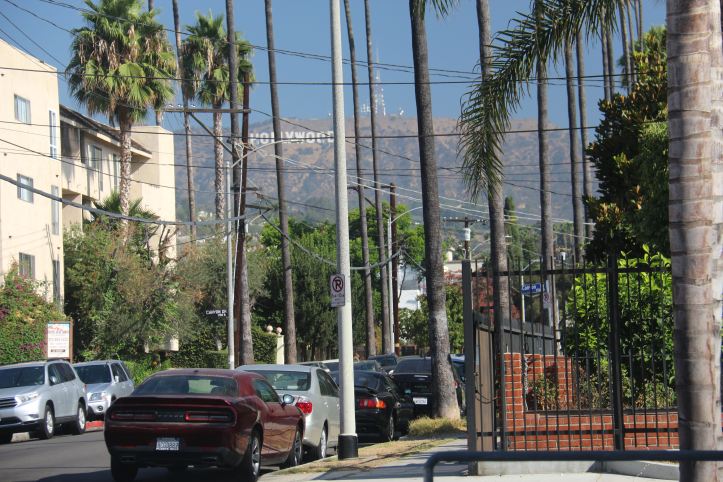
On the road again
Goin’ places that I’ve never been
Seein’ things that I may never see again
And I can’t wait to get on the road again….
Twenty one days, two and a half thousand miles….
The flight carries you from Manchester, high over the Arctic, across Canada and down the American west coast to Los Angeles International. Eleven hours. Prufrock measured his life out with coffee spoons. Even after all these years, I still measure out long trips with ‘O’ level English Language papers. Three hours. Enough time to deal with a comprehension, write a story and put away a preçis. One is straightforward. Two, bearable. Three? Getting close to waterboarding. By the time we touch down at LAX (doesn’t that sound luxuriously self-indulgent?), I’m in desperate need of strong coffee and a good shower.
We book into the Coral Sands Motel, on the borders of Koreatown and Little Thailand in the heart of Hollywood. Like a lot of Hollywood, wander off the main strip and it can look a little down at heel, but the motel is clean, convenient and extremely welcoming. It was built in the 1940 when the USA was not yet at war and presumably commissioned by an architect who had previously specialised in State penitentiaries. Two storeys of typical motel rooms line a rectangular courtyard. At some point, someone made the decision to dispense with the suicide nets and instead, in the middle, is a tropical garden with palm trees, a communal pool and a large plunge pool complete with hydraulic chair lift. However, it’s marvellous to be just around the corner from a supermarket that opens for twenty hours a day. Wine, beer, food, shower and sleep. That’ll do for a start.
California is very aware of litigation. The majority of hotels carry signs that warn you that the building contains materials that might cause death or serious sickness and all the pools thoughtfully warn – in LARGE red letters – anyone who has had or has diarrhoea to keep well away. Oh, and enjoy your swim…..
Hollywood
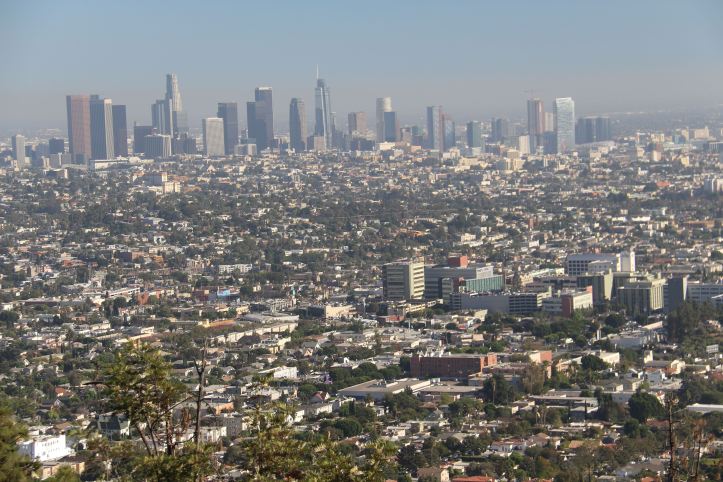
Five minutes walk and we’re on Hollywood Boulevard. Street names that have been with me for decades: Hollywood and Vine, Sunset Boulevard, Sunset and Vine…. Over 2,500 stars have their bronze plaques in the pavement of the Walk of Fame. It started back in 1958 and is all about ‘making a dollar and getting by’. Stars from way back from the worlds of music and film, and Donald Trump. Hollywood Boulevard takes you the full length of the Walk of Fame, down past the Capitol Records building. Sadly, it’s no longer open to the public and the young security guard seems a little bemused at the interest we pay it, but there’s no denying its status and the four Beatles have their stars embedded in the granite outside.
The Dolby Theatre, home of the Oscars, attracts the expected crowds as does the Egyptian Theatre, complete with painted hieroglyphs. We stop to study the pavement outside the Chinese Theatre where over 200 Hollywood celebrities have put their handprints, footprints and autographs in the concrete and left fond messages to Sid Grauman, the theatre’s founder. They’re all there: Gene Autry, Clark Gable, Kirk Douglas, Lauren Bacall. As well as Champion the Wonder Horse and Trigger. It is Hollywood, after all.
Up the road is the Hollywood Museum. It’s housed in the old Max Factor building and is a fascinating insight into the early years of stardom and the silver screen. I’m almost thrown at the cash desk by what I think is an automaton collecting money and handing out tickets. Just at the very last moment, I realise that actually, she’s real. She’s just had so much work done, none of her features move. She’s extremely blonde with eyebrows that she must keep in a box in the drawer at home. Through a mouth that a ventriloquist would envy she ‘gottles her gear’ at us.
Where are you guys from? (‘guys’ must be easier for her than ‘folks’)
Ah, Wales. (that was tricky). Tom Jones, Davy Jones – so many people called Jones.
My wife tells her that she used to be a Jones before marriage.
REALLY? …..WOW? ……REALLY?
A flicker of movement around the eyes?
I chip in. I tell her that there’s also Richard Burton and Anthony Hopkins and Stanley Baker….too much information. The features set again, the light goes out of the eyes, we collect our tickets and move on. It’s a fabulous museum, not only for the costume and the insight into the career and work of the Factor family, but also for the artefacts that bring back so many memories from childhood. Costumes from all those Sunday afternoon films, the original Batmobile, Hannibal Lector’s cell….
Dodging Catwoman, the Hulk and Superman who seem to be on every corner, wrangling too many dollars out of anyone foolish enough to pause long enough to have their photograph taken with them, we head for what is to be the highlight of the day.
The Hollywood Forever Cemetery and Crematorium lies within a few acres of carefully manicured lawns. It’s what is referred to as a ‘subscription’ cemetery, so many of the plots have been taken over by wealthy Eastern European and Jewish families. But the central mausoleums are the final resting places of the Fairbanks dynasty and the de Milles.
I know it’s ridiculous, but I’ve always been fascinated at the way that cinematic fame immortalises the individual. Kirk Douglas might be 101 this year, but, for me, he’s still up there, in glorious technicolour, wearing his chain mail arm guard, XL underpants and brandishing the short sword. Film freezes you in time, but eventually, everyone finds their way into the same sized plot of earth somewhere or other. And Hollywood Forever has become the final home for, amongst others, Fay Wray, Jayne Mansfield, Toto from The Wizard of Oz, Johnny Ramone and Don Adams (remember Max Smart, Agent 86?)
As we leave, it’s ironic that, not more than a couple of hundred yards away, it’s all carrying on regardless, here in tinsel town. Everywhere there are companies advertising sound studio space and voice-over coaching; star trailer accommodation and catering supplies. The cycle continues. The public is insatiable.
Before we move on, there’s time to head to higher ground and the Griffith Observatory. It’s the best place from which to see the iconic Hollywood sign as well as being worth a visit in its own right. I have to admit that, stars of the celestial type take very much a back seat and I’m far more moved by, at last, being so close to nine forty-five foot high wooden letters stuck on the side of Mount Lee. But then again, I’ve always been a bit shallow!
Santa Monica and Venice Beach
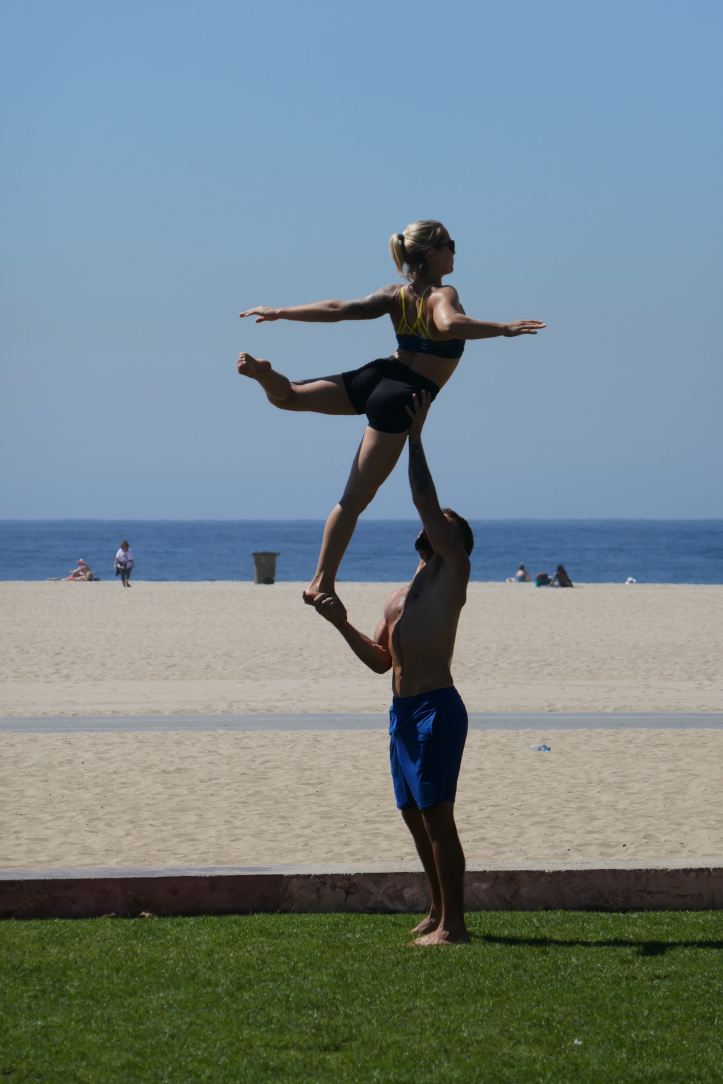
I’ve always thought that Baz Luhrmann’s 1996 Romeo and Juliet was filmed in Santa Monica. After all, I thought, ‘Verona beach’ and ‘Venice Beach’ must be a play on words. I don’t think I can be on my own in being wrong. In fact, Verona Beach is a hamlet (small village, not the Dane….) in Oneida County, New York State and the beach scenes were filmed in Miami. Still, there’s still more than enough reasons to catch the metro from central LA out to the coast.
Santa Monica is bright, it’s brash but it’s also very, very pleasant. The beach is incredibly long and wide and the pier is as traditional as you would wish it to be. As Sheryl Crow would say, as soon as ‘the sun comes up over Santa Monica Boulevard‘, the city comes to life and people flock in, tourists and locals alike. The sand is spotlessly clean and, while the sea might be a way off, the expanse means that if you’re into beach activities you can easily find a space where you’re not bothering anyone else. I don’t think I’ve ever seen such beautiful sand and that includes many of the beaches in the Aegean.
Santa Monica was the birthplace of ‘Muscle Beach’, home to those types who want to ‘work out’ beyond common sense and reason. Today, Muscle Beach lies three miles south at the adjacent Venice Beach. It’s an easy walk along a cycle / pedestrian pathway that follows the edge of the sand all the way. Venice Beach is busier and less organised. It has its own canals tucked away off the main strip. A collection of tasteful houses linked by salt-water canals and a most desirable area, I’ve no doubt. The main promenade is busy with hippy shops, psychic readings, tourist paraphernalia, bric a brac, bars and restaurants. There’s a very impressive skate park and also a caged workout area for the shy, retiring types who fear having sand kicked in their faces. No, not really. The four gladiators we watch, three men and a woman, are clearly pumped full of steroids and boosters. There’s a lot of grunting and ‘yo-ing’, high-fiving and oiled chest slapping. The watching crowd are respectfully quiet. Perhaps they don’t have enough faith in the eight-foot high mesh fencing to take liberties. The little man from Puerto Rico who stands next to me turns, exhales loudly and then whispers:
Do you think they could hurt you if they got out?
I ask him how fast he can run …….
We leave them to their weights and dumb-bells; their posing and their bulging veins. I’ve got sand in my eye and a bus to catch.
The Afro-American bus driver is stunningly attractive. She looks as though she’s going for a model shoot and she can’t be more helpful. She drops us at the station and we catch the Metro back to Union Square, one of the most beautiful railway stations I’ve ever seen. It’s the ‘Last of the Great American Railway Stations’, classic and opulent and feels considerably older than its 1939 build. It lies on the edge of the original Spanish settlement of LA and it’s only a short walk to the Pueblo de los Angeles and the Avila Adobe, the oldest surviving house in the paseo which dates from 1818. It’s lovely to see a community that still gathers to dance in the square and to share food on a sunny afternoon.
The community of the pueblo celebrate the antiquity with pride, but you have to remember that, in the grand scheme of things, it’s not all that old. As a man in the tourist office reminded me:
I’d like to think that we have all the nature but you have all the history. I mean, you can go all the way back to 1066.
I point out that we can go back a lot further than that and so can the native Americans, but you tend to find that they still separate history into pre-colonisation and post-colonisation, the latter being ‘proper America’. Homeland Security? The native Americans have been fighting terrorism since 1492.
A couple of closing thoughts. It’s evident that homelessness is a problem here. Well, not just here…all over the states we visit. Whilst there are charitable concerns that hand out support, there seems to be more individuals than with which they can cope and the numbers who sleep and live rough seem high. We pass whole communities living in makeshift plastic and cardboard houses on underpasses and in tunnels, sometimes with their own little bookshelves of shared books. We pass body after body on the streets, begging for money. One sign read: ‘Needed – money for drugs and whores’. As a business plan, it might not be the best of ideas but it certainly has a unique selling point. Mind you, when you pass someone huddled in a corner on the street, clearly living rough and they’re texting on their phones, it does make you wonder….just a little….
And finally, it’s interesting the way that this country treats its veterans. People fly flags because they have national pride. They are everywhere. If it was the same in the UK, it would be seen as a political statement. Here, it’s national pride. So many men wear baseball caps or ‘lids’ as they’re called and so many of them are embroidered with military associations. Car registration plates proudly announce their owners being veterans from Korea or Vietnam or Iraq. Intercoms in shops, stations and airports welcome the military and thank them for their service. Veterans are invited to request discounts for goods and for entrance to attractions. People on the Metro stand to allow a veteran their seat. We may have ‘Help for Heroes’ on t-shirts and car stickers back in the UK, but here it’s tangible support at every turn.
Route 66: Los Angeles, California to Bullhead City, Arizona
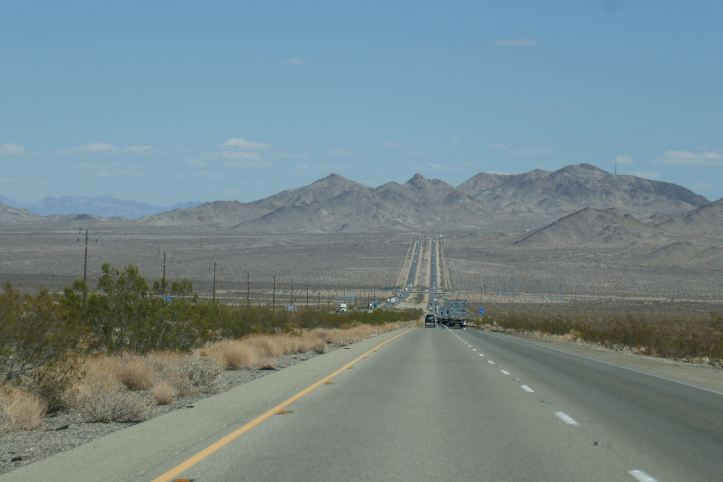
The route out of LA takes you through suburbs with names that evoke all manner of associations. Glendale, Pasadena, San Bernardino and then out on the interstate, through the foothills of the Sierra Nevada and out into the Mojave desert. Highway 40 had all but replaced Route 66 by the mid 50s. There are sections of the old Highway still visible from the interstate and sections that have been renovated as part of a historic route and helped to save many a small town from being lost into times gone by.
Route 66 dates from 1913, although the original route was a camel track as early as 1857. By the late 1920s and early 1930s it was a major route for families moving to California from Arkanas, Oklahoma, Kansas and Texas in search of work and to escape the Great Dust Bowl. The Joad family in Grapes of Wrath travelled the Route 66 in their rickety converted Hudson. Re-routing by the 1960s saw the decline of the old Route 66 and today it holds a nostalgic and historic place in the hearts of many who travel it – almost with an air of pilgrimage.
The Mojave desert is stunningly beautiful. Big skies, huge mountain ranges and absolutely straight roads. We set the cruise control at 65 mph and sit back to enjoy it. Driving is easy even with the large numbers of huge trucks that use Highway 40 as a regular route. They fill the rear mirror and bring back memories of Dennis Weaver in Duel (1971). As we pull away on hills, I can’t help but look back and say ‘You can’t beat me on the grade, you can’t beat me on the grade!’
Just outside of Barstow we pull off the road and head for Calico. We’ve seen the sign to the town painted on the hill to our right and discover that it’s an old mining town that was deserted and has now been taken over as a tourist attraction. It was built in 1881 to take advantage of the fact that ‘there was silver in them there hills’ and despite the fact that the townsfolk built a hotel, school, general mercantile store, assay office, sheriff’s office, church and jail, everything folded within twelve years as the ore ran out and so did the population. The Regional Parks run it today and keep the properties in their original state whilst offering the usual run of tourist requirements.
On through Needles to Bullhead City (Days Inn) on the banks of the Colorado. The temperature is rising and it’s 120F when we arrive. Bullhead City used to be known as Hardyville and stands on the righthand bank of the river with Laughlin on the left. The latter is all hotels and casinos and the former hotels and population. A free ferry works the river twenty-four hours a day and a local airport brings in the punters and the dollars. It’s not an attractive town and we’re only here for the night but we wander down to the river bank to watch people enjoying their Saturday watersports and picnics. During the summer, the town is crowded with RVs and skidoos but it’s so hot the air burns the nostrils as you breathe in. Every lamp post carries a banner celebrating the military contribution of a son or a daughter from the city. Nearly every house displays a star and stripes and baseball caps as as much about celebrating military service as they are about supporting the Dodgers, the Wolverines, or whoever. This area is thick with training camps: Fort Irwin, National Guard Armoury, Combat Division Camp….the list goes on and on.
We see our first evidence of the biker pilgrimages down Route 66. The Outlaws pull into town. Mandatory Harley Davidsons, bandanas and leather embroidered jerkins. I suspect some of them have been ‘outlaws’ for many a year judging by the way they stretch as they get off their bikes, their expansive waistlines and lack of hair. I’m reminded by some words penned by John Cooper Clarke, the Salford bard in Psycle Sluts:
on a BSA with two bald tyres
you drove a million miles
you cut your hair with rusty pliers
and you suffer with the pillion piles
There seems to be a general willingness to engage in conversation that feels slightly alien to the reticent reclusive Brit. In Safeway, the assistant tells me, without any prompting, that her mother is paying off the loan on her brother’s truck (he’s 39 years old) and she wonders whether she’s going to get some sort of reciprocal treatment herself? The man behind me tells me that his grandson is going ‘off the rails’ down in Texas and that he’s come in to buy beer as he needs cheering up today. I’m trying to desperately think of something to say about the six chicken wings and the coleslaw I have in the basket and failing dismally. I decide to retain British reserve and smile sympathetically while appearing to have a total loss of articulation. Hopefully, they think I’m German or Dutch or something…..
Route 66 : Kingman to Williams, Arizona
Sunday morning in Kingman. It’s dead. I thought that being on the Route 66 and therefore a natural stopping off point, they would have organised themselves in to having the shops and attractions open, but no. However, it’s a fascinating town. It’s the first place I’ve seen ‘Make America Great Again’ posters and many of the shops are clearly hoping for great things from their Republican President. The man who sits at the picnic table, nursing a beer at 11 a.m. and stroking a long grey beard sports a red ‘Trump’ baseball hat and rejects a smile from a tourist carrying a camera and wearing a Manc-Holidays T shirt.
Kingman seems to have ignored the overtures of Sacha Baron Cohen and his suggestion that the town builds itself the biggest mosque in America. However, it’s retained its railway and has a fine example of a Western Santa Fe locomotive complete with carriages. Many of the shops are given over to Route 66 memorabilia and there are more than a few classic 1950 cars both on show and for sale.
It’s quite a contrast in Seligman, some 30 miles further on and a town that is absolutely buzzing on a sunny Sunday. More bikers have arrived and the streets are full of Harleys. Most of them seem to be from Germany and the riders are ‘of a certain age’. This is serious biking and I sit in the Roadrunner cafe enjoying a Coke and a sandwich watching a group of them eating lunch and chatting. I imagine that in a couple of weeks they’ll be back home picking up their lives again, gowned-up in theatre, preparing legal cases or managing industry. This is not a cheap holiday for them, that’s for sure. All the groups seem to have a U-Haul van shadowing them, presumably bringing along their clothes, bags and Germoloids from stop to stop.
The freight train passes. I count the wagons and lose track when I get to a hundred. The whistle is as atmospheric and lonely as it was when it was driven by steam and wherever I go it can be heard away in the distance. More than once I’ve lain awake at night listening to its mournful sound and thought of all those others for whom the sound might mean escape from being trapped in small town living or lamenting opportunities lost.
Back in the cafe, I’m approached by a grizzled biker. He points at my T-shirt. It’s got Lambretta written across the front. He asks me whether I had my first bike before my first girlfriend or after. I tell him before. He then asks whether, if I had my time again, would I have kept my first bike or my first girlfriend. My bike, I reply. He laughs and then says ‘Right answer, and I like the shirt’ and then wanders away.
Along the route we pass convoys of geriatric bikers riding their twilight dream on Route 66. Leather waistcoats with sewn patches, jeans, boots, bandanas, beards, moustaches, shaved heads. There is definitely a look. They cruise at a respectful speed and wave as you pass. They still look as though they ‘represent freedom’ as Jack Nicholson once said in Easy Rider.
Finally, we reach Williams (Travel lodge) , in Coconino County, Arizona. Here are the first cattle and sheep I’ve seen since arriving in the States. It’s a peach of a town. One way in and one way out. The railway follows the main street and it’s gloriously atmospheric. Bill Williams was a mountain man, trapper and scout who gave his name to the town back in 1881. Today it stands as a gateway to the Grand Canyon with a population of a little over three thousand. It boasts a rich heritage of the old west and shares this tastefully with tourists who stop here rather than making the extra hour’s drive to Tusayan, the town nearest to the Canyon.
We’re a lot higher up and the temperature is pleasant with almost chilly mornings. In the evening clouds develop. Will it mean rain? A local shopkeeper tells me she’ll believe it when it hits the ground. It hasn’t rained for three months. Even in ‘monsoon season’, as she calls it, it only rains for about 15 minutes at a time.
At the local Williams Brewery we drink Mexican beer – with or without salt. We talk to a couple from Milwaukee, Wisconsin. He tells us he’s heard of Wales, England but knows nothing about it. He’s surprised that I know that Milwaukee has a strong German population and that’s why it became the centre for a big brewing industry. He’s also surprised that I know it was the home of Spencer Tracey. He admits he knows nothing about Wales (we’ve now separated it from England) so I tell him about Gareth Bale (never heard of him) and at Tom Jones was Welsh (he never knew that). I draw him a map on a beermat and trace the route of the Romans and the Vikings. My other half introduces him to the Welsh language. Fair play, he hasn’t stifled a yawn by now, although his wife has made her second trip to the rest rooms. However, she becomes more animated when she hears Welsh. She tells my wife that she must have had a good teacher as her English is impeccable. That goes down well….almost as well as the bill when we realise the beer was $7 a pint. We drink up and leave.
The Grand Canyon

Nothing prepares you for it. You set out on a road that is as straight as an arrow and drive for fifty miles. The country side is flat desert scrub. Not a hill in sight. And then the ground simply falls away…..277 miles long, up to 18 miles wide and over a mile deep. Must have been a great shot for Garcia Lopez de Cardenas who was the first European to see the Canyon back in 1540. Mind you, let’s remember that, by then, native Americans had been trekking up and down the canyon for thousands of years…..
But I’m getting a little in front of myself. Tusayan at the entrance to the Canyon has developed since 2010 as a starting point for tourists arriving by plane to the purpose-built airport. It’s a holiday village and hotel complex and pretty ghastly – and expensive.
This is the South Rim. To get to the north rim involves several hours of serious driving, even though you can see the north rim less than two miles away. We bought tickets on line to avoid the queues and we get there by 10 a.m. It’s already busy and this is getting towards the end of the season. It must be murder when the schools are closed for the summer. It’s costing $35 for the car but that gives you an unlimited seven day pass.
It’s hard to drive through the entrance when you’re being stopped by someone dressed as Ranger Smith without doing a Yogi accent – especially when there are signs about not feeding the bears from your ‘pic-a-nic basket’. I defy anyone to say that without doing the accent. We park at the Visitor centre and take the shuttle bus west – the Hermit’s Rest trail. It’s the only way you can do the western viewpoints. The bus sets off. It stops, you get off, walk a few feet and then……wow! and I mean WOW!
Nothing prepares you for the size, the grandeur, the majesty of it all. It’s just breathtakingly and staggeringly impressive. Karl Pilkington might have thought the Great Wall was the Alright Wall but I defy him not to be impressed with this. It is epically Grand.
We take the six viewpoints west as far as Hermit’s Rest. It was named by Louis Boucher back in 1891 when he prospected at nearby Dripping Springs. The buildings that exist today were designed by Mary Colter who specialised in Mission revival and Colonial revival architecture. Big fireplaces, log cabins, Hopi-style stone buildings. They exist all over the park and are typical of what would have been there had the colonialists left them alone in the first place.
Back at the Visitor centre we head East and take in the remaining view points. You can hike down to the bottom, camp and walk back up but it’s not for the faint-hearted and certainly not manageable in a day. Of course, you can also reach the bottom by helicopter, but that’s not for the faint-hearted either, especially when you open your Visa statement. The Colorado can be seen far away at the bottom of the canyon and the rapids are used for white water rafting even in the driest of summer months. As the day goes on the light changes and the rocks change colour. It’s every Western you’ve ever seen rolled up into one vista. It is sublime.
At Powell Point, the view down the river would have been the same when John Wesley Powell made it in four canoes back in 1869. They make a significant issue of the fact that this is the first recorded passage by white men. Less so, of the fact that unrecorded passages had been going on for centuries. Nevertheless, I wonder if he was stunned, exhilarated or terrified. Probably all three.
Route 66 : Sedona
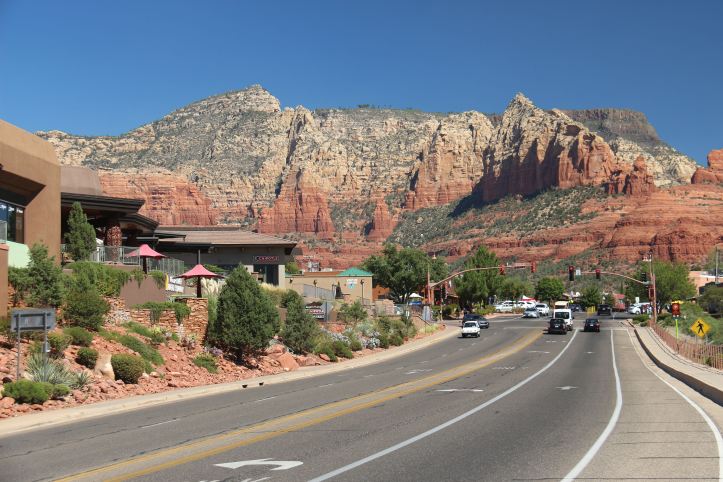
Sedona at 5000ft above sea level straddles the Coconino and the Yavapai forests. It’s a city built in the foothills of sandstone mountains and it plays with the light throughout the day. Until 1876 it was home to the Yavapai and Apache Indians until they were forced out onto the reservation some 180 miles south east. About 200 have returned and now make their living in the valley providing useful attractions for tourists. In one of the local shops, one told me that there was no such thing as an Indian reservation. There were areas of land to which they had been sent to live but in fact, the whole country is theirs. It had been, it is and it will be. End of.
Up until the 1970s, Sedona had been a centre for Hollywood Western film making. The hotel had accommodated most of the big names. John Wayne made Tall in the Saddle, Burt Lancaster made Desert Fury. Jeff Bridges made Starman and Elvis had made Stay Away Joe. It’s still trading on its reputation for having some of the best scenery around and being where Madonna lives…..
Nearby Flagstaff is a large city and home to the South Arizona University. It’s a lot to take in unless you have time but the road between Flagstaff and Williams takes you deep into a gorge with the most beautiful mountain scenery and you climb up, leaving the valley bottom behind, until you reach the vantage point at the top and can stop to admire the views. This is cowboy country and, in some respects, very little has changed.
Route 66 : From Williams, Arizona to Las Vegas, Nevada
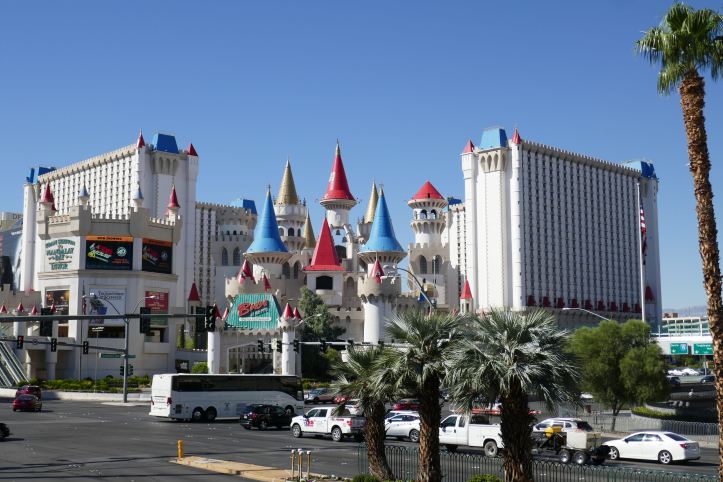
Anyone who know me will also know that I have an aversion to retracing my steps. If I can’t do a circular walk, I don’t go. Even when shopping, I have to return to the car by an alternative route. However, on this occasion, I have little alternative.
We leave Williams and back-track to Seligman. Ok, that’s that done with. Let’s move on.
Taking the old road out of Seligman, we head through Peach Springs, Thruxton and Valentine. One horse towns. Well, they were once. Unfortunately, the horse has been sold and made into glue and burgers. Blink and they’ve gone. It’s a good job the scenery is spectacular.
This is Hualapai Indian country and fortunately, the next town is Hackberry on the Hualapai Reservation. As a town it’s virtually non-existent but it has the most amazing gas station and General Store. Well, in fairness, the gas station closed about 50 years ago. It’s a former mining town with a population of 58, at the last count. In 1875, Jim Music came to prospect at a silver mine he’d bought. Unfortunately, he fell foul of the local Indians and by 1919, the town was almost deserted apart from the Grigg family, who still live there today. The General Store is now part museum, part cafe, part shop. The 1950s memorabilia is worth the visit alone as is the collection of beat up cars that litter the plot.
Just outside Kingman lies Chloride. We’re still in Arizona, just. 352 souls live in what was once a silver mining town and now still dabbles, making it the longest continually-mined town in the state. It was founded in 1863 and the buildings are all original thanks to the prompt action of Louis L’Amour who was visiting when it caught fire and organised a bucket brigade that prevented the town being destroyed. Whilst Calico has been taken over and is presented as a tourist attraction, Chloride simply hasn’t bothered. It’s an untidy mess of originality. Things remain where they dropped maybe half a century ago. Attractive it isn’t, but unique it certainly is.
The Hoover Dam lies between Chloride and Vegas. It sits on the border between Arizona and Nevada and straddles the Colorado. It was built during the Great Depression between 1931 and 1936. The water is impounded in Lake Mead, the largest reservoir in the USA and it provides power for Arizona, Nevada and California. In these days of heightened security, it’s not surprising that the checks and precautions are extensive. Cars are searched by sniffer dogs and soldiers. Bags and bodies are searched and all security guards are armed to the teeth. In fact, there’s not a lot to see when you get there unless you go on an organised tour but the Hoover Dam is the Hoover Dam and the box gets ticked!
Las Vegas, Nevada
Where do you start? We spend two days in Vegas at the Luxor. Why the Luxor? Well, it certainly makes a statement. But then again, find me a hotel in Vegas that doesn’t. We check in to Room 18503 – that should tell you something. I’ve booked an enormous sloping pyramid room that looks out over the strip. It’s Vegas Vulgar – that really should be a term.
There are clearly downsides to Vegas. perhaps we should dispense with those before we get going?
- It’s ridiculously expensive. If you’re prepared to pay $29 dollars for an eight-inch pizza then you’ll be happy. $4 for a small bottle of water? $12 for a draught beer? You can see pattern appearing here.
- Seediness. Small Asian men are constantly hanging around on the streets pressing cards into your hand offering to send girls to your hotel rooms by the hour or by the evening. Anything seems to go. They are nasty little individuals who are scruffy in the extreme. Show girls, wearing nipple covers and little else, work in pairs to separate your dollars from your wallet in return for a photograph. Many of them are barely out of school and very scantily dressed. Lorries drive up and down the strip advertising Marijuana which can be delivered to your room (it’s legal in Nevada). You can smell it on every street. Cocaine also seems to be freely available, there are adverts everywhere.
- Sad Gamblers. Step out of your room for breakfast and the casinos are already busy. Invariably women, many on mobility vehicles with oxygen tanks attached and almost all of them grossly overweight, are sitting at slot machines from dawn until dawn. They still allow smoking in the casinos so as not to lose your attention if you need to go for a ‘fag break’. There are no windows in any of the casinos so you don’t know whether it’s day or night. House staff fetch you drinks, top up your credit cards and do everything except bring around commodes. How many of them are whittling away at grocery checks? Pensions? Savings? It’s very, very sad. The whole raison d’etre for Vegas is that those who have too much do their utmost to take away from those who can’t afford to lose anything and probably everything.
- Beggars. There are plenty in Vegas. The logic of begging in a city where people have money to give away sounds reasonable. However, it’s not going to you. It’s going to the corporate entities who own the most. I wonder how many of those in desperate situations have become like this because of Vegas and what it does?
- Carbon footprint. Vegas is fed from the electricity generated at the Hoover Dam. Nothing is regenerated or recycled. Traffic drives up and down the Strip every minute of every day of every year. Its carbon footprint must be horrendous. They say that it’s surprisingly small but the data only takes in residents, not visitors and their policy for producing renewable energy is way behind target and has slowed down during the current administration. Hmmm?
The Strip is alive and buzzing 24 hours a day. It literally never sleeps. The shops never close, the hotels never stop. You check out electronically and the room is recycled for the next occupant.
The Hotels are defined by their theme and their tackiness. MGM is just flash. Bellagio is ornate and actually rather posh. Hotel Paris is all Eiffel Tower. The Venetian comes complete with a Bridge of Sighs, the Rialto, a Doge’s Palace and the Grand canal has gondolas. Excalibur has a plastic castle and drawbridge, a Robin Hood restaurant and Sherwood Forest Bar. Well, I suppose chronological order would be too much to expect. The Luxor has a Sphinx and a Pyramid with blue laser light and Amenhotep in the Foyer. Room prices are not high, not compared with the rest of the States. It’s get them in and then rob them blind. It’s a good business model. It’s interesting that when you get talking to people, there are many, many visitors who are prepared to put up with eating on the hoof just to experience the city and not end up bankrupt. More junk food must be consumed per head per day than in any other place outside the theme parks of Florida. Outlets like McDonald’s, that are resisting the temptation to raise their prices, do a roaring trade. Except for McDonald’s there are no water fountains, no benches, no shelter. Everything has to be bought to be consumed.
Overall. Vegas is like stepping into some sort of Mad Max dystopian reality. It’s brash. It lacks emotion and it lacks heart. It’s aimless. It is a city of artifice. Anything natural is contorted into something else. People live in a twilight world staring mindlessly at little lights spinning their money away. Nothing is sincere, not even ‘Have a nice day’.
We spend an evening at the Copa Rooms of the Tuscany Suites watching The Rat Pack is Back. It is a small intimate setting behind a velvet curtain with a Dean Martin, a Frank Sinatra and a Sammy Davis Jnr lookalike who take us through the big numbers accompanied by a six piece band. They’re good, but you can’t help thinking that even this isn’t real. It’s all a sham.
Oh, and I saw Elvis. He is alive and well and living in Vegas. I say ‘well’ – he was on a mobility scooter and his polyester suit was a bit stained and shoddy. He was with a showgirl who was wearing fishnet tights and a thong. They were outside Walgreens at 3.30 in the afternoon sharing a cigarette…..it’s now or never, I suppose.
So, what is the positive side of Vegas? Well, I know people who have married here and they’ve been very happy. Would I recommend you coming here? Of course. You need to experience it for yourself. No doubt there will be many who love it. It’s bonkers. It’s just that I left my rose-coloured glasses back home.
Beyond that? The best thing about Vegas is the Route 95. It heads west out of the city and I’m looking forward to being on it.
From Vegas to Lone Pine
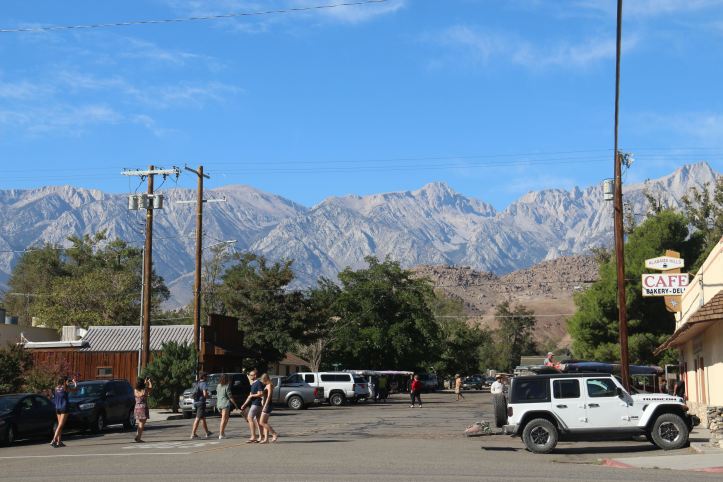
Leaving Vegas, driving out through the residential suburbs, you get a sense of how this place is growing. They’re building housing estates on scrub land with nothing for miles except glittery Vegas. Affordable living? Desirable living? Not really.
The road takes us out past Pahrump and into Death Valley. I’ve got 10 litres of water on board and am slightly thrown by how good the road surface is. I was expecting much worse. But this is a well-travelled route and there’s never more than ten or fifteen minutes where I’m absolutely alone in the wilderness. Mind you, we watch the altitude drop from 6000 ft to minus 262 ft as we descend into the valley towards Badwater Basin. Places have such good names around here. Furnace Creek, Death Valley Junction, Stovepipe Wells. It hearkens back to an earlier time when the road was barely a track and this was hostile country. We pass sand dunes and scrubland, buzzards and road kill. Nothing between you and the horizon apart from the heat haze and then, after many miles, we come to a ‘T’ junction……and an Opera House.
Back in the 1920s Amargosa was a boom town. Borax mining was at its peak and the Pacific Coast Borax Company built a company town and brought in the railroad. 350 people lived in the middle of nowhere. The hotel catered for clients and visitors to the mine. In 1942 the railroad was torn up and the tracks and stock were sent to Cairo, Egypt. Gradually, everything started to fall into disrepair and the population left. Then, in the 1960s, Marta Becket arrived. She had broken down and was awaiting repairs to her car when she came across the hotel. She bought it, started renovation and opened an Opera House. Her final show was in 2012. She died in 2017 at her home in Death Valley Junction aged 92. Where on earth she popped out to for a pint of milk and a loaf beats me.
Today, Death Valley Junction has a population of four and the Opera house is open for tours and occasional performances. It’s all rather strange!
The impact of Borax Mining and the natural landscape can be best viewed at Zabriskie Point just by Furnace Creek. Temperatures here can reach 125 F. Today it’s a balmy 100.4 degrees. The landscape is stunning. Undulating rock hills with only the barest of scrub stretch away into the distance. The Shoshone Indians made this their home. Over the years the government tried to move them away to the reservation but this land constantly pulled them back and today they still live in their communities in the harshest of landscapes and environments.
At the end of Death Valley, the country changes and the road climbs out of the basin and into the mountains. At the foot of Mount Whitney and the Sierra Nevadas is Lone Pine and we book into the Whitney Hotel on the Main Street. Lone Pine is a popular stop for climbers and back packers as well as being the home of the Paiute people. High Sierra with Humphrey Bogart was filmed here and John Wayne, Tom Mix, Bing Crosby, Gene Autry, Barbara Stanwyck, and Jeff Bridges all stayed at the local hotel. It’s a very pretty town with a proper ‘saloon’ with swing doors! There’s something about a bar with swing doors. You want to rush in, stop the piano player, shout ‘The Daltons are in town!’ before rushing out again.
Needless to say, we didn’t. However, it did go rather quiet for a moment when I pushed open the doors, adjusted my belt and walked in. The blonde barmaid might have looked better had she not been in such a rush that morning and forgotten her teeth…the place had five customers, two sat at the bar, dressed the same way in baseball caps and overalls, drinking bottles of beer and two men playing skittles out the back. I was hoping she’d slide a glass down the bar to me, but I think times have moved on. We drank Mexican lager and then we left. I was told off for walking backwards towards the door with a toothpick between my teeth…..
Mammoth Lakes and Mariposa
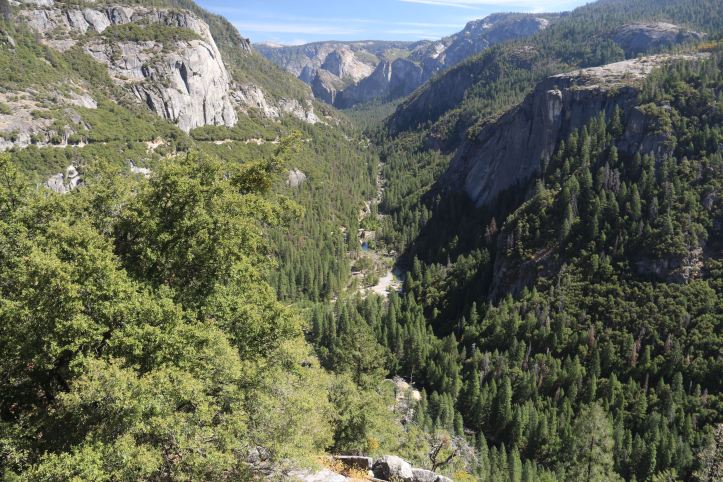
Mammoth Lakes is a ski resort in Mono County, California. Like a lot of ski resorts it looks its best under a good layering of snow. We check in to the Quality Inn and wander out to see what the town has to offer. It’s an attractive town full of traditional shops and buildings that look well cared for and ooze Western charm. Don’t think I can say the same about the people, mind. It’s as though they’ve been told to be on their best behaviour during the season so they can let off a bit of steam in the summer.
The main bar at the Outlaw Saloon is heaving. It’s full of locals being very loud and the language is colourful, to say the least, The waitress comes over with the bill and politely suggests a 25% tip. She would have to be very polite to get that…along with a proposition of marriage and the keys to her car. If she’d said ‘Stick ’em up’ and helped herself, it would be the only way she’d get 25%. However, I hadn’t reckoned on it being a bargaining stance. We then receive an amended bill offering an 18% tip.
I hope she wasn’t too disappointed with the 10% we actually left. Actually, I hope she was. It would be a good lesson in humility.
At the far end of Mammoth it was Oktoberfest. It’s September, for a start and where on earth had the lederhosen come from? The festivities attract a very small group of participators. I couldn’t stretch to calling it crowd. A few die-hards sit around drinking from large steins and watching another few die-hards ‘tossing the keg’. And that is about it. So much for Oktoberfest. However, down the road at the Mammoth Brewery, things are different. Bearded types in checked shirts and big boots are sloshing back a variety of craft beers at craft beer prices. Most seem to be wearing T-shirts proclaiming links to plumbing or construction. It’s all very macho.
Coming down to breakfast before we leave we’re told that we’ve had bears in the garage during the night. Their sense of smell is so acute that you’re advised not to leave any food in cars and if out picnicking, you’re required by law to put anything edible in sealed steel containers provided by the Park Commission. We tiptoe into the garage to load up the car. The navigator is worried that the bears might still be around….I’m desperately concerned that they’ve found the Haribo in the glove compartment.
Between Mammoth and Mariposa lies Tioga Pass. It’s Route 120 and cuts right across Yosemite. Closed in the winter, the snow gates open once the snow thaws and the road presents an ideal way to cross one of the most beautiful National Parks in California. It’s 150 miles of slowly winding roads through beautiful forest tracks. Eagles and buzzards circle overhead, waiting for cars to pass so they can dip down and help themselves to the road kill : racoon, fox, coyote, skunk. Mammal road-sense still needs a bit of work. Crossing the Tioga Pass is a good idea. It’s a $35 toll, but well worth it.
Mariposa is another old mining town. The Aqua Fria creek produced gold for a while back in 1851 but boom-times came and the new town of Mariposa sprung up when they hit a significant source of placer ore. We check in to the Miner’s Hotel and wander down into town for a drink. I’m not sure what’s the problem with finding barmaids in this part of the world. Presumably there is a job requirement that they have to look threatening and be able to take care of themselves. Invariably, they are brusque, no-nonsense and, quite honestly, a bit on the rough side. Barmaid Training at the Correctional Facility must be a tough course to pass. Still, it’s yet again, another pretty town with bags of character.
San Francisco
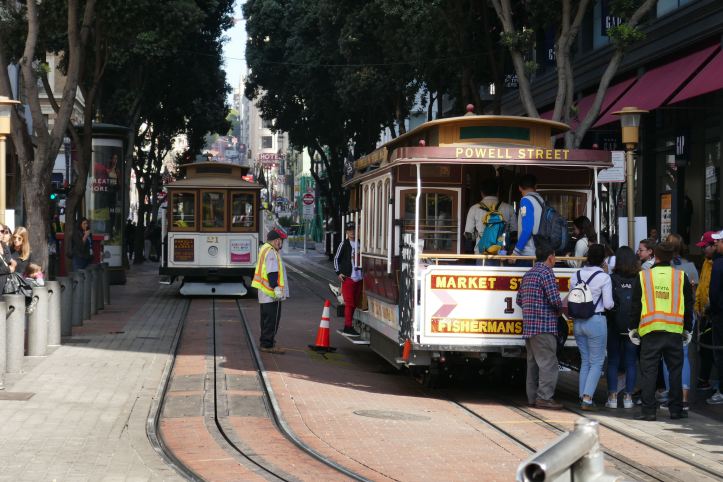
At last we reach San Francisco. We wanted to stay right in the middle of the city, but Sales Force have their Dream Force marketing conference on and with 171,000 delegates, prices for hotel rooms have gone through the roof. Five nights in a brand hotel is starting at nearly $4000. It’s a blessing in disguise, actually. Instead, we opt to stay across the bay in Oakland in the most wonderful Airbnb apartment (click for details).
We have an impression of San Franciscans. They’re healthy and fit, living the dream out on the West coast. Our hosts fit the bill, perfectly. This part of Oakland is mainly given to Victorian clapboard houses with timber porches and sash windows. Ours is tucked away off the street behind another and is owned by Ross and Shannon who, I presume, move out when visitors move in. The book shelves are full of tomes on self-improvement and the psychology of living. The larder says ‘Organic’ from top to bottom and there are enough supplements and health products to keep you going for the next few years. We’re encouraged to make good use of the gym, complete with inversion table, cross trainer, trampoline, recumbent cycle and weights. I take them at their word and rig up a washing line between the cross trainer and the exercise bike….somewhere to air the smalls….
I’m afraid the sauna remains unused as well….There’s a Mancunian on holiday for you!
The house is lovely. It’s warm, homely and welcoming. Big fridge, big bed, big shower, big kitchen stove. As you’d expect, a great place to come back to after a hectic day’s sightseeing. I open a bottle and walk over to the 50-odd inch television, sneering at the gym as I pass and flop down to watch what’s on offer on American channels. Sad to say, it’s all shopping channels, cookery programmes and news. Oh dear, I miss the BBC and thank goodness they’ve got Netflix and Amazon.
As you can imagine, the supermarkets are full of everything. Californian milk is always from cows not treated for RBST (Bovine somatotropin) and all the chicken and beef is free-range and grass-fed. There was nothing on show that pointed the way to chlorinated chicken – perhaps that’s all in a large warehouse waiting for Brexit? Everything is in BIG PORTIONS, though. The fruit and veg is wonderfully fresh and diverse and the delicatessen choice in even the smallest of outlets is extensive.
It’s only ten minutes walk away from the Bay Area railway station and twenty minutes later we’re right in the heart of the city. That’s what makes Oakland so convenient as somewhere to stay when you’re over here. As a suburb, it was plague ridden back in the 1900s but soon became a large community in its own right with a population of 400,000. It’s connected to the city by the Bay Bridge and also by the BART tunnel and downtown Oakland is as cosmopolitan as it can be. The Black Panthers started off in Oakland and it is also home to Seasick Steve and Tom Hanks. In their time, Frank Oz, Buster Crabbe, Clint Eastwood and Bruce Lee lived here. Now isn’t that eclectic enough for anyone?
High on a hill, it calls to me
To be where little cable cars climb halfway to the stars
The morning fog may chill the air, I don’t care….
Putting an itinerary together for San Francisco means being systematic. It’s a city you can wander around but there are clearly ‘must-sees’. Here’s ours…….
Day 1 : The Piers, Fisherman’s Wharf, Russian Hill, Lombard Street and the Coit Tower
It doesn’t start well. Remember the Manchester Arena bombing of 2017? Well, after that, I bought a Manchester Bee t-shirt. Now the worker bee has been the symbol of Manchester since the Industrial Revolution and recently, it’s been rejuvenated into a symbol for Manchester as a city and as a community. The T-shirt is a very plain black with a tastefully printed white bee on the front breast. It’s very subtle, or so I thought.
So, I’ve just crossed the road from Embarcadero in SF and I’m heading to the beautifully white Main Port building when I get shouted at from a man who is passing:
Hey, pops! What’s with the stingy bee?
Pops? POPS?
Then a young girl crosses over and grabs my arm.
Hey, can I have a photo of your T-shirt?
This is San Francisco where image is everything. They walk, cycle, mono cycle, skateboard, segway and run their way along the 39 piers that make up the waterfront.
The walk from Pier 1 to Pier 39 takes us down past the cruise liners and the sea lions at Pier 39. Originally on Seal Rock, out in the Bay, they started hauling themselves onto the main dock back in 1989. Today, there are about 150 of them. Each of them is half a ton of noise and stink! Their diet does them no favours!
Eventually we get to Fisherman’s Wharf. It’s very commercial and busy. but its one of those places you should visit. There are a couple of historic US naval vessels: a submarine, the US Palamito and a Normandy convoy ship, the Jeremiah O’Brien that are worth a look, if not a tour. From here on a very good day, you might even get to see the Golden Gate bridge. However, the cold air of the ocean meeting the warm air of the Bay means that, more often than not, the bridge is covered in fog and barely visible. But, you might be lucky.
If you can, pop into the Musee Mechanique. It’s a great collection of old fairground slot machines, many dating from the early 20th century. The ‘English Execution’ is worth a look. A few cents enables you to watch some poor soul being strung up and dropped through a trap door to meet their fate. Delightful.
From Fisherman’s Wharf we walk up to Russian Hill and Lombard Street. You can go up via the iconic trolley buses. They’re cheap enough and, hopefully, the queues won’t be too bad, but we walk. The streets are steep. The one from Fisherman’s wharf takes you Hyde and Powell and onto Russian Hill is a 31.5% climb, that’s 17.5 degrees. However, the view from the top is amazing, We walk down the zig-zag of Lombard Street, a 27 degree incline, where real estate must carry a ridiculous number of noughts.
Over to the right is Coit Tower. It’s the highest point in San Francisco and from the top there is a stunning vista looking out 360 degrees across the city. It was built in 1933 and you’re carried to the top in a lovely brass decorated elevator. The lady managing the controls turns to me:
I’m a Bear. (pronounced ‘Burrrrrr’)
I beg your pardon?
I can see you’re a Bee. Ah’m a Burrrrr.
I see….no, sorry, I don’t….
It turns out that the Bears is a charitable organisation that she joined when she graduated. They link the gay community with the city in raising money for local charities. Their Facebook page is worth further investigation, believe me. Go on, click the link….
From the bottom of Coit Tower, we pass the Joe di Maggio playground and it’s only a short walk to the St Peter and Paul Church on Filbert Street. Big enough to be a Cathedral, it’s where Joe and Marilyn Monroe married in 1954 and his funeral was held here in 1999. It’s lovely inside and cool enough to make a stop for a rest before heading back down to the waterfront, grabbing a beer on the way home while you watch the pelicans and contemplate that Filbert Street was used to film Dirty Harry back in the day.
Day 2 : Chinatown and Japantown
There are so many places to visit. We contemplated hiring bikes and cycling over the Golden Gate bridge to the redwoods on the other side. They have a scheme whereby they’ll collect the bikes and you can catch a shuttle back if it’s too much for you.
But, we didn’t. Instead, we went to Powell Street and on to Chinatown.
Most large cities have their Chinatowns. The area beyond the Dragon’s Gate is the oldest Chinese community in the USA. It was established in 1848 and now has a population of 35,000. Although the Chinese originally came over to the US to build the railways, a significant proportion of those in Chinatown today are Hong Kong Chinese and the area has developed its own culture and identity. It’s an enclave that still supports its own shops, languages, customs and social clubs. Many are monolingual Mandarin or Cantonese.
I’m in a store specialising in Chinese art looking at a facsimile terracotta warrior. The assistant comes up to me and in very broken English asks if she can help. I tell her that I was in Xi’an in 2016 to see the warriors and it was very busy. I tell her I also went to Beijing. She is Chinese, she barely speaks English but she has only been to China once in all her life Last year she went to Beijing. I ask when she came to America. She tells me she was born here. And yet, she can barely hold a conversation in English. Such is the strength of the Chinese community.
It feels very Chinese. They have their own style of lamp posts. Buildings are decorated to look Chinese. All the signs are Chinese first and English second. It’s not a ghetto, it’s very much a community.
Crossing Nob Hill, we enter Japan Town. Such a different feel to this area. Six city blocks for a population of about 1400. The Japanese started settling here after the earthquake of 1906. By the late ’30s there was a thriving community here; and then came Pearl Harbour.
In 1942, Roosevelt signed Executive Order 9066 and all Japanese citizens were rounded up and interned in concentration camps on the Pacific coast. Many of the buildings in Japan town were razed to the ground or taken over by African-Americans. After the war, a small group returned and re-established a community. The government built shopping malls and small blocks, but clearly there was little will or interest in designing anything attractive or in spending unnecessary money on such ventures. It all has the feel of being rather Brutalist. The large Peace Pagoda was a gift from Osaka, the community’s sister city. Unfortunately, many San Franciscans feel it resembles a nuclear mushroom cloud.
Interestingly, children from the area are all educated at the local Rosa Parks Elementary School. The irony didn’t escape me.
We’re quite a way out. Fortunately, a rather camp Japanese chap with three chihuahuas and butterfly clips in his hair directs us to the bus stop and we catch the city transit back to the Pier.
Day 3 : The Helicopter and Alcatraz
Day Three is Big Treat Day. We’re picked up by shuttle bus from outside of the Hilton downtown and taken out to the Executive area of San Francisco airport. There’s six of us. Two Swiss men who I ask if they are father and son. They tell me that they are partners and I get a very sharp dig in the ribs from she who thinks she must be obeyed. There’s a small Malaysian girl called Winnie who is cabin crew on Malaysian airlines, us two and a chap from Florida who is in town because his girlfriend is at the sales conference.
We take off in a very small Bell helicopter and fly out over the city, over the Bay and under the Golden Gate Bridge. We’re all wearing headphones but I don’t realise that they’re all ‘mic’ed up’ together. As we drop rather suddenly to dip under the bridge Winnie starts making rather strange noises. Despite being cabin crew, she’s clearly not comfortable in the front seat with the driver and the noises continue, getting ever more high pitched.
I turn to Mrs H.
Is she having sex up there with the pilot? She sounds as though she’s having an orgasm.
That’s when I realise we’re all ‘mic’ed up together’. All I hear is laughter through the earphones and a very red faced Winnie turns to look at me…..
It’s a fabulous tour and comes highly recommended. I booked ours through GetYourGuide. I’ve used them a few times and they’re totally reliable. We are dropped off at Sausalito and then catch the shuttle back across the Bridge to Pier 39.
Part two of the Big Treat starts when we board the ferry to Alcatraz. As a sight, it’s pretty much at the top of my Bucket List and it’s something I’ve waited nearly a lifetime to do. I’ve been brought up on Burt Lancaster and The Birdman of Alcatraz, Edward G and Jimmy Cagney films, stories of Al Capone and Baby Face Nelson. Machine Gun Kelly and Whitey Bulger. And here I am, on the ferry, heading over to probably the most famous prison in the world.
It’s quite an experience. It’s freezing cold and very, very windy. The audio tour is incredible. Warders and ex-cons have put it together and it’s a superb guide to the cell block, the history and the attempted escapes. Sitting in the exercise yard on the steps looking over the bay to the city, you realise how near SF really is. It’s easy to imagine New Year’s Eve and the noises from the Yacht Club parties echoing over the water to the island. It must have been very depressing. Actually, sitting on the steps takes me immediately to scenes of Andy and Red at Shawshank. OK, I know it’s not the same prison, but the room attached to the warder’s office with the microphone and record player could just as easily be here as anywhere.
The prison shut in 1963 and was immediately taken over illegally by Indian tribes who tried to set up a Free State of San Francisco. Why they would want to on such a depressing and barren outcrop beats me. Anyway, today it’s run by the National Park Services and they do a very good job.
Day 4 : Shopping
No apologies. We always have a day shopping. Well, we manage half a day at the Nordstrom Centre. Mrs H. shops and I spend enjoyable time people watching. And this is a city where the people are really worth watching. From the stylish to the bizarre. We head back late afternoon to Oakland and have a look downtown before heading home to pack.
At the corner of West and 42nd Street in Oakland stands a low bungalow with a white metal fence around it. Each day we’ve passed, an elderly African-American gentleman has been sitting on the porch drinking coffee. We’ve taken to waving and we have a conversation about where we’ve been and what we thought about it.
Today I stop and tell him we’re leaving tomorrow but we’ve had a lovely time.
Well, have a good holiday. I’ll remember youse two. The nice man and his good lookin’ wife
This isn’t my wife! It’s my mother….
As we walk away and until we turn the corner onto 43rd street all I can hear is a raucous chuckle followed by It’s my mother…..it’s my mother…..Lord above…..it’s my mother…
They’re nice people around here.
Highway 1 to Paso de Robles
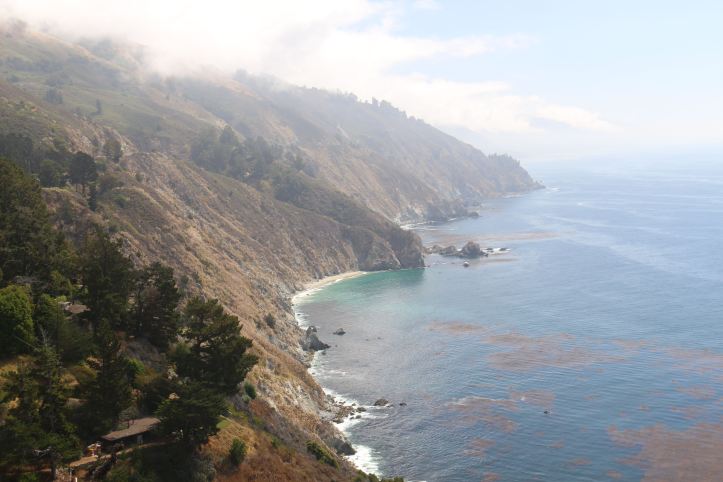
Then somewhere near Salinas, Lord
I let him slip away
Lookin’ for the home I hope he’ll find it…
Highway 1 is also known as the Pacific Coast Highway. It stretches from San Francisco south, eventually breaking out at sea level and following the coast. It’s one of the few major routes with bends and it produces a whole new driving challenge for American motorists. It’s also frustrating. Everybody seems to brake to a ridiculously slow speed to go around the bends, even when they’re not particularly sharp. Coming from the mountains of North Wales, I was a little under-whelmed at times but I couldn’t understand why, with a speed limit of 55 mph, we couldn’t all maintain road speed.
The road takes you out through Carmel, where Clint Eastwood was Mayor, down to Monterey and Salinas. We’re in Steinbeck country and there’s a Steinbeck Center to visit if you have time. From here it’s down to Big Sur and on 74 miles of beautiful coastal road. The whole route is 650 miles long, but we’re coming off it at Paso de Robles.
Paso de Robles is in wine country. The rocky coastal countryside gives way to south facing terraces of grapevines and notices offering tours, tastings and music. Paso de Robles is a lovely little town used to accommodating wine buyers and tourists alike.
We pull into the Melody Ranch Motel for the night. The owner came here in 1951 after his parents, German immigrants, moved north from LA. He’s been here ever since, as has 90% of all the fixtures and fittings. It’s spotlessly clean and phenomenally well-maintained, complete with original lemon tiles, metal Kleenex dispensers and authentic neon signs.
Next door is the main town’s hotel. It’s been here for quite a while. Jesse James worked here as a bus boy during his teens. That’s quite something to take in bearing in mind he died in 1882, being shot in the back of the head by that coward, Robert Ford.
The town is also home to Hunter Tylo (you must remember, she played Amelia in the blockbuster Hammerhead: Shark Frenzy?) and the baseball player, Russell Kuntz, who for reasons best known to himself, allowed his friends to call him Rusty.
I get another sharp dig in the ribs for suggesting he sounds like a madam from a retirement home bordello……
Sometimes it’s an absolute pleasure to sit at the counter of a breakfast diner and wade through fresh orange, cremated bacon, hash browns, toast, eggs (sunny side up) and endless coffee. Being California, of course, you receive a disclaimer when you order your eggs sunny side up. It informs you that eating raw or uncooked eggs can be injurious to health and YOU HAVE BEEN WARNED! We read it carefully along with the menu at Vick’s Cafe where big breakfasts has been served daily since 1942.
It was George Bernard Shaw who, back in 1940, said that we were two countries separated by the same language. We all have our bête noir when it comes to English / American translations. I come across a shop named ‘You say tomato’ and an English bar that welcomes its guests with the notice ‘no wankers’. But for me, it’s biscuits and gravy. It’s as far away from any English translation as you can reach. Who on earth in the UK would want to pair the two together? And then you realise that they’re not biscuits after all, but rather soft dough rolls. The ‘gravy’ is actually a roux that they call sawmill gravy, a combination of fried dripping, flour and milk. Sometimes they add bits of sausage for effect and lots of black pepper for taste. It has the colour and consistency of a parsley sauce. I’m yet to be convinced……
On to Santa Barbara
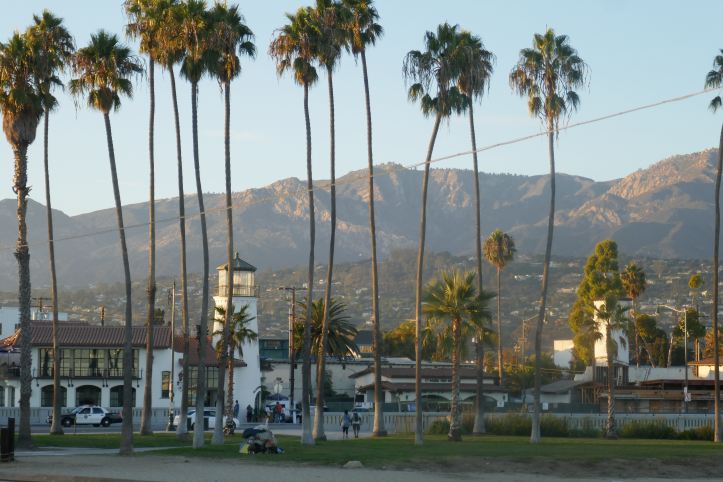
Pulling off the road, we head to Los Alamos – the Cottonwoods. It’s Festival day and the main street is pedestrian only. It’s the home of Luke Branquinho, seven times world steer wrestling champion and a proud son of the town. Everybody has turned out in the Sunday finery. This is a town that is half American and half Mexican… and it shows. Half of the men are walking around in shiny cowboy boots with cuban heels, freshly ironed Wranglers, sharp shirts and stetsons, while the other half sports sombreros and decorated chaps.
There’s a band warming up, a display of old agricultural equipment and the saloon is doing good trade. A steam organ pipes out hits from the Confederate Song Book –
Yes, we’ll rally round the flag, boys, we’ll rally once again,
Shouting the battle cry of freedom
The National Rifle Association have set up stall on Main Street. You can sign up today – they take Mastercard and Visa. And they’re raffling off six shotguns. There doesn’t seem to be a restriction on how old you have to be to buy a raffle ticket, either. The man in front of me is buying two tickets. I have to admire the handgun strapped in a holster and hanging low, cowboy style. It’s serious stuff round here.
We have to move on and an hour or two later, we pull into Santa Barbara. It’s not what I expected. The Mason Beach Inn is just off the beach front and is very pleasant. There is no high-rise here. The back drop is the mountain range and it’s a remarkably pleasing and affluent resort. Apparently, Tom Cruise has made his home here, which would explain the Church of Scientology, as have Oprah Winfrey, Whoopie Goldberg, Jennifer Lopez, Steven Spielberg and Kevin Costner. And you can see why.
Main street is mainly stucco shops that are independent and classy. It feels a very safe town and the pier, which allows vehicle access, leads down to a few attractive fish restaurants and a viewing point for watching the sun go down over the mountains.
It’s a very sandy beach and, as a result, the water churns it up and doesn’t make it the most pleasant for swimming. However, it’s the Pacific and it deserves a paddle. But, my God, is it cold! Even after the summer it has had; day after day of high temperatures, the water is still as though it’s come straight from the Arctic.
I like Santa Barbara and I’m glad we’re here for two days. It’s restful.
Back to Los Angeles
Returning to Los Angeles we drive up into Beverley Hills via Rodeo Drive. I want to see 333 Copa de Oro and 750 Bel Air Road. I know there are coach loads of people who want to see where people like Sylvester Stallone lives, not to mention Taylor Swift. But, for me, there are only two houses to see: No. 333 Copa de Oro was where Milburn Drysdale, Manager of Beverley Hills Bank lived, and 750 Bel Air Road, home to Granny Daisy Moses, Jethro Bodine, Jed and Elly May Clampett and Duke the bloodhound, of course. Remember Duke? He used to drink from the ‘see-ment pond’.
Unfortunately, armed security, high gates and hedges make spotting very difficult and the best you can do is look from outside and wonder. But, it’s all there in my memory….even if it is in black and white.
So, twenty one days and two and a half thousand miles later, we’ve come full circle. As we wait for the flight to be called, I think about the fact that we’ve seen so much beautiful country and so many curiosities I can understand why people are drawn to this part of the world. I need to come back again. Not here, necessarily, but this is a big country. I think it’ll be Utah, Wyoming and Montana next…or maybe Kentucky, Tennessee and Louisiana.
I know, I’m spoilt for choice.
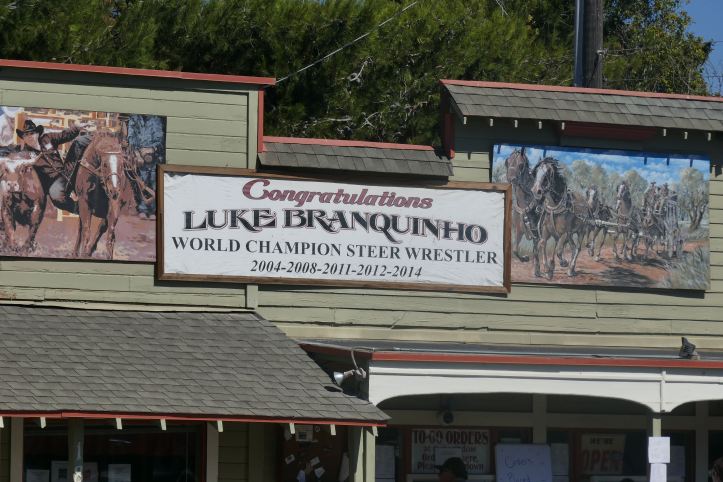
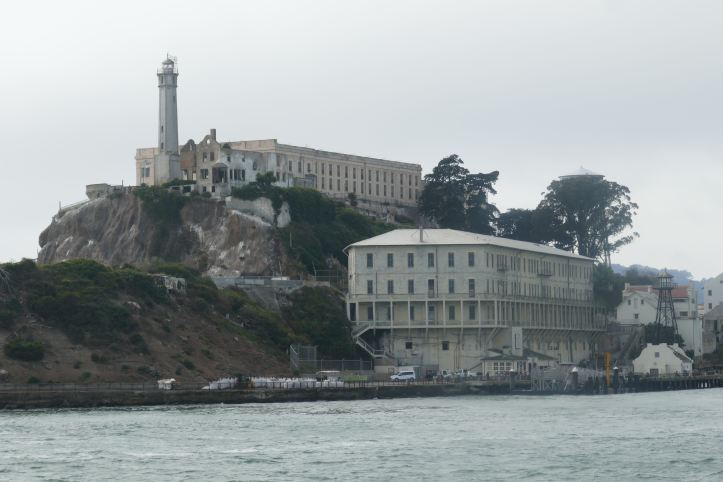
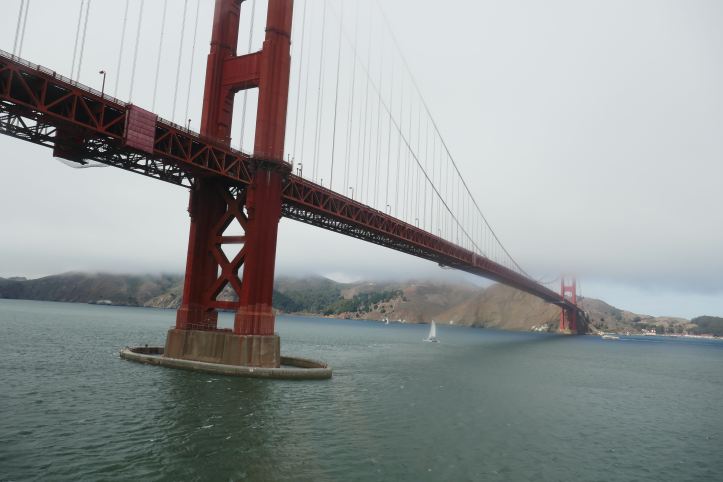
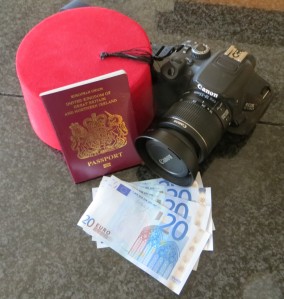
Reads like 3 hour O level English test did you well. Reminded me of lots of places we’ve visited in the States.
LikeLike